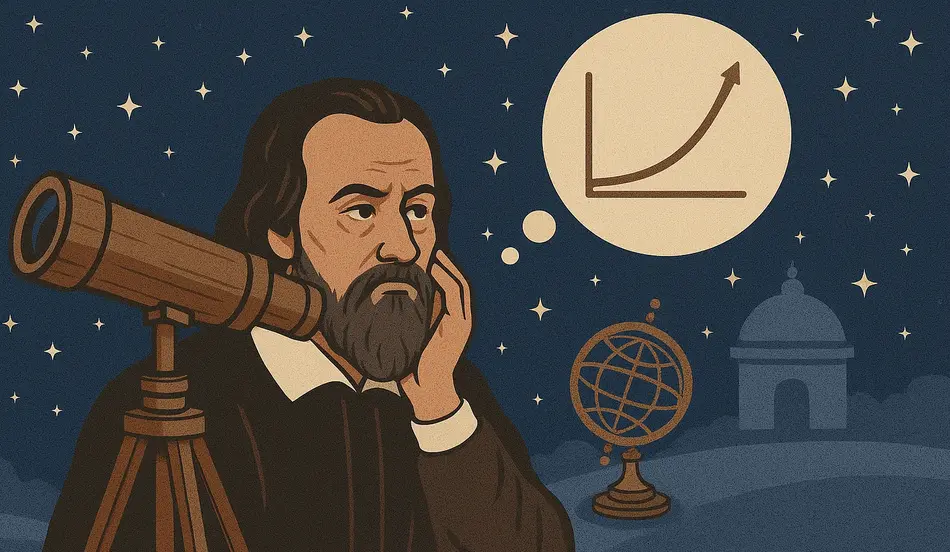Scientific discovery took a monumental leap forward in the early 17th century with the development of logarithms one of history’s most transformative mathematical breakthroughs. This innovation revolutionized scientific calculation and empowered astronomical research that would redefine humanity’s understanding of the universe. At the heart of this revolution were the brilliant minds of Johannes Kepler, Tycho Brahe, John Napier, and Joost Bürgi mathematicians and astronomers whose perseverance and ingenuity ignited a new era of exploration and insight.
The Astronomical Challenge That Changed History
In the year 1600, a theology student and mathematics teacher named Johannes Kepler journeyed to Benatki Castle outside Prague, seeking an opportunity that would change the course of scientific history. Kepler had been developing radical new theories about planetary motion, but he needed precise data to transform his ideas from speculation to proven science. The only person in the world with measurements accurate enough to test Kepler’s theories was Tycho Brahe, who had recently established himself at the castle after being forced to leave Denmark.
Tycho Brahe possessed the most valuable astronomical data of his time—20 years of meticulous planetary observations that he guarded like treasure. When Kepler arrived, Tycho presented him with a challenge that would ultimately revolutionize our understanding of the universe: mapping the orbit of Mars.
Mars had been particularly problematic for astronomers. The planet made complex loops in the sky and appeared to speed up and slow down over time. Tycho had gone to extraordinary lengths to gather accurate data on Mars, even building a specialized underground bunker at his previous observatory to obtain undisturbed measurements.
Kepler, confident in his mathematical abilities, bet he could solve the Mars problem in just eight days. He was wrong. It would become the most challenging task of his career, eventually leading to discoveries that would fundamentally change our understanding of the cosmos—but only after a mathematical innovation called logarithms made such calculations feasible.
The Computational Crisis in Early Scientific Discovery
When Arithmetic Strangled Scientific Progress
It’s almost impossible for us to imagine today, but one of the greatest obstacles to scientific advancement in the early 17th century was basic arithmetic. Scientists routinely spent months performing calculations that we now complete in seconds. Multiplication and division of seven-digit numbers were tedious, error-prone processes that consumed enormous amounts of time and mental energy.
Kepler’s approach to solving the Mars problem illustrates this computational bottleneck perfectly. He employed a strategy of guessing parameter values, then performing complex calculations to test if they worked. When the numbers didn’t align with observations, he would revise his guess and repeat the entire process. This trial-and-error method combined with brute-force computation required Kepler to repeat the process 70 times over the course of a year.
Making matters worse, Kepler frequently made arithmetic mistakes that took several iterations to identify. This computational struggle wasn’t unique to Kepler—it was the reality for all scientists of the era, effectively limiting the pace of discovery across all scientific disciplines.
Early Attempts at Computational Efficiency
Ideas for speeding up calculations had been circulating since ancient times. Michael Stifel’s 1544 book Arithmetica Integra described a method using geometric progressions and what he called “exposed numbers” (what we now call exponents). By creating tables of powers (such as repeated multiplication by 2), one could potentially convert multiplication problems into addition by looking up the corresponding “exposed numbers,” adding them together, and finding the resulting value.
The fundamental insight was powerful: multiplication could be transformed into addition, and division into subtraction. However, this approach had a critical limitation—it only worked for the exact values listed in the table. As numbers grew larger, they became increasingly spaced apart, making precise calculations impossible.
What was needed was a way to solve the spacing problem—a method that could provide a continuous mapping between geometric and arithmetic progressions. This breakthrough would arrive in the form of logarithms, a mathematical innovation that would transform scientific calculation forever.
The Race to Develop Logarithms: Bürgi and Napier
Joost Bürgi’s Red and Black Numbers
Around the same time Kepler was struggling with his Mars calculations, a brilliant clockmaker and mathematician named Joost Bürgi was developing his own solution to the computational problem. Bürgi, who had been called “a second Archimedes” by a previous employer, recognized that using smaller ratios in geometric progressions would place the values closer together, enabling more precise calculations.
Bürgi created test tables using repeated multiplication by 1.1, generating what he called “red numbers” (the results of the multiplication) and “black numbers” (the indices or positions in the sequence). By using this approach with a common ratio very close to 1 (specifically 1.0001), Bürgi could achieve up to 9 digits of accuracy.
His method involved several steps:
- Dividing the numbers to be multiplied by powers of 10 to bring them within the table’s range
- Looking up the corresponding “red numbers” and adding their indices
- If the result wasn’t on the table, using a scaling step to bring values back into range
- Adjusting the final answer by the appropriate power of 10
While Bürgi likely completed his tables around 1600-1610, he didn’t publish them until 1620. By then, his work would be overshadowed by a similar invention from Scotland.
John Napier’s Logarithmic Revolution
John Napier, a Scottish nobleman better known for his apocalyptic writings than his mathematics, was also keenly aware of the computational challenges facing astronomers. After years of work, he developed a more sophisticated approach to the same problem Bürgi was tackling.
Napier’s breakthrough came through a complex analogy involving two moving points. He imagined one point moving along a finite line segment with continuously decreasing velocity (proportional to the remaining distance), while another point moved along an infinite ray at constant speed. Equal ratios on the first line corresponded to equal distances on the second—effectively transforming multiplication into addition.
He called his system “logarithms” (from Greek: logos meaning proportion and arithmos meaning number). To create practical tables, Napier approximated his model using a geometric series with repeated multiplications by 0.9999999 (1 – 1/million). Recognizing the needs of his intended users, he tailored his tables specifically for astronomers and navigators by creating logarithms of sine values rather than simple numbers.
When Napier published his tables in 1614 after 20 years of work, he was already 64 years old and in declining health. Yet he insisted his work “be made common to all and be freely available for public use.” His wish would be fulfilled beyond his wildest dreams.
Learn more about the historical development of mathematical concepts at the Mathematical Association of America’s Convergence.
📈 Hiring? Connect with Mathematics and Data Science Professionals
Are you recruiting for roles that demand strong mathematical or computational skills? Post your openings for free on WhatJobs and attract top talent in data science, advanced analytics, mathematics, and quantitative research.
🚀 Post Your Jobs for Free TodayKepler’s Breakthrough: How Logarithms Unlocked the Laws of Planetary Motion
The Rudolphine Tables and Kepler’s Third Law
After Tycho Brahe’s death in 1601, Kepler was appointed Imperial Mathematician for the Holy Roman Empire. He took control of Tycho’s precious observational data and inherited the responsibility of completing the Rudolphine Tables—comprehensive charts that would predict the motion of all planets and chart the positions of 1,005 stars.
This monumental task would take Kepler 22 years to complete, during which he would discard not just Tycho’s geocentric model but essentially all existing astronomical theory. His work on Mars led him to his first two laws of planetary motion:
- Planets move in elliptical orbits with the Sun at one focus
- A line connecting a planet to the Sun sweeps out equal areas in equal time intervals
These discoveries came only after Kepler made a crucial decision based on an 8-minute discrepancy between his circular model’s prediction and Tycho’s actual observation of Mars. Rather than dismissing this tiny error, Kepler wrote that “these 8 minutes alone will have led the way to the reformation of all astronomy.”
Kepler obtained Napier’s logarithms around 1617, and they transformed his work. Not only did logarithms dramatically speed up his calculations, but they also revealed patterns in the universe that had been hidden in the noise of raw data.
When Kepler applied logarithms to compare planetary orbital periods and their distances from the Sun, a simple linear relationship emerged that led to his third law of planetary motion: the square of a planet’s orbital period is proportional to the cube of its semi-major axis. This mathematical harmony was precisely the kind of cosmic order Kepler had been seeking his entire life.
The Perfection of Logarithms
Shortly after Napier published his tables, English mathematician Henry Briggs proposed an improvement. By setting the logarithm of 10 equal to 1, every integer part of the logarithm value would correspond to a shift of the decimal point by one place—creating what we now call base-10 logarithms.
Napier enthusiastically supported this refinement, but his failing health prevented him from completing the work. Briggs calculated the new tables himself over the next eight years.
Meanwhile, Kepler redid the logarithm tables according to strict Euclidean principles and included them in the opening pages of his Rudolphine Tables, which were finally published in 1627. These astronomical charts were 30 times more accurate than any previous tables and could calculate planetary positions back to 4000 BCE and far into the future.
Explore the modern applications of Kepler’s laws in space exploration at NASA’s Solar System Exploration.
The Legacy of Logarithms: 350 Years of Scientific Calculation
From Napier to the Moon Landing
The impact of logarithms on scientific progress cannot be overstated. For the next 350 years—until well into the 20th century—every mathematician and scientist from Newton to Einstein to Oppenheimer relied on logarithm tables and slide rules for their calculations.
The tables published by Napier and Briggs became the standard reference for generations. Remarkably, certain small errors in their original works propagated through subsequent publications for over 200 years, as no one bothered to recalculate the tables from scratch—a testament to the monumental effort required to produce them initially.
Beyond mere calculation tools, logarithms evolved into a broader mathematical concept. Logarithmic functions became essential for modeling numerous physical phenomena, from sound perception to entropy calculations. It’s fair to say that the computational power provided by logarithms enabled humanity to put a person on the moon.
The End of an Era
The era of logarithm tables and slide rules finally ended in 1972 with the introduction of the first handheld electronic calculator. Yet even then, Napier and Briggs had the last laugh—the programming hardwired into these devices used the same computational algorithms that Briggs had developed to calculate base-10 logarithms over 300 years earlier.
Today, logarithms remain fundamental to numerous fields, from information theory to finance, from acoustics to earthquake measurement. What began as a practical tool to ease the burden of calculation has become an indispensable mathematical concept that continues to shape our understanding of the world.
Tragically, when Kepler wrote to thank Napier for his revolutionary contribution to science, he didn’t know that Napier had already been dead for over two years. Yet their intellectual connection across time and space exemplifies how mathematical innovation builds bridges between minds dedicated to unlocking the secrets of the universe.
Find mathematics and computational science jobs on WhatJobs
FAQ: Revolutionary Logarithms in Astronomy
How did logarithms revolutionize astronomical calculations in the 17th century?
Logarithms revolutionized astronomical calculations in the 17th century by transforming the most time-consuming mathematical operations—multiplication and division—into the much simpler operations of addition and subtraction. Before logarithms, astronomers like Johannes Kepler spent months performing tedious calculations, with each multiplication of seven-digit numbers requiring extensive manual computation. This computational bottleneck literally “strangled scientific progress,” as Kepler demonstrated when he had to repeat his Mars orbit calculations 70 times over the course of a year.
What was the relationship between Johannes Kepler and Tycho Brahe, and how did it impact the development of revolutionary logarithms in astronomy?
The relationship between Johannes Kepler and Tycho Brahe represents one of the most consequential scientific partnerships in history, creating the precise problem that revolutionary logarithms would eventually help solve. When Kepler arrived at Benatki Castle in 1600, he was a brilliant mathematician with innovative theories but no data to test them. Brahe possessed the world’s most accurate astronomical observations—particularly of Mars—but lacked the mathematical insight to make sense of them. Their partnership was initially rocky; Brahe was notoriously protective of his data, while Kepler was eager but temperamental. Despite their personality differences, they developed mutual respect, and Emperor Rudolph II commissioned them to create comprehensive new star charts called the Rudolphine Tables.
Who were the key figures in developing logarithms, and how did their approaches differ?
The development of revolutionary logarithms in astronomy involved two primary innovators working independently: John Napier and Joost Bürgi, each approaching the problem with distinct methods. Napier, a Scottish nobleman better known for his apocalyptic writings, developed logarithms through a sophisticated theoretical framework involving two moving points—one moving with continuously decreasing velocity along a finite line, the other moving at constant speed along an infinite ray. This conceptual approach allowed him to transform multiplication into addition by showing that equal ratios on the first line corresponded to equal distances on the second. After 20 years of work, he published his logarithm tables in 1614, specifically designed for astronomers by providing logarithms of sine values.
What lasting impact did logarithms have on scientific progress beyond astronomy?
The revolutionary logarithms in astronomy sparked a computational transformation that extended far beyond celestial observations, fundamentally accelerating scientific progress across all disciplines for over three centuries. Immediately after their introduction, logarithms became essential tools for navigation, enabling safer and more accurate maritime travel during the age of exploration and global trade. The mathematical concept quickly evolved beyond mere calculation aids into logarithmic functions that proved instrumental for modeling diverse physical phenomena—from sound perception (leading to the decibel scale) to earthquake measurement (the Richter scale), from information theory (where logarithms quantify information content) to thermodynamics (in entropy calculations). Every major scientific advance from the 17th to the 20th century relied on logarithmic calculation; Newton, Einstein, and Oppenheimer all used logarithm tables or slide rules for their groundbreaking work.
Explore career opportunities in scientific research on WhatJobs
Conclusion: Mathematical Innovation as the Engine of Scientific Revolution
The story of logarithms reveals a profound truth about scientific progress: advances in calculation methods can be just as revolutionary as theoretical breakthroughs. The computational power unleashed by logarithms didn’t just make existing work faster—it made entirely new discoveries possible by revealing patterns that had been hidden in the noise of raw data.
Kepler’s third law of planetary motion, discovered through the application of logarithms, provided the mathematical foundation that Isaac Newton would later use to develop his theory of universal gravitation. This chain of discovery, from Tycho’s meticulous observations to Kepler’s mathematical laws to Newton’s universal theory, represents one of the greatest triumphs of the scientific method.
The parallel development of logarithms by Napier and Bürgi also demonstrates how the pressing needs of science often drive mathematical innovation. Both men recognized the computational bottleneck facing astronomers and developed solutions that transformed not just astronomy but all of science.
Today, as we face new computational challenges in fields ranging from climate modeling to genomics, from artificial intelligence to quantum physics, the legacy of logarithms reminds us that innovations in how we calculate can be just as important as what we calculate. The next revolutionary mathematical tool might unlock patterns and relationships that currently remain hidden in our data, waiting to be discovered.
Discover opportunities in computational science and technology on WhatJobs




